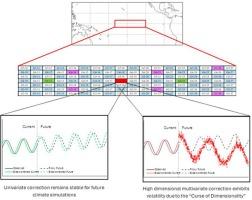Revisiting model complexity: Space-time correction of high dimensional variable sets in climate model simulations
IF 3.1
Q2 GEOSCIENCES, MULTIDISCIPLINARY
引用次数: 0
Abstract
Multivariate bias correction (BC) models are well-known to correct more statistical attributes in climate model simulations. However, their inherent complexity and excessive parameters can introduce higher uncertainty into future climate simulations. In contrast, univariate BC models, with fewer parameters, are limited to correcting certain attributes. An issue that has not been investigated in-depth is the impact of an increased number of variables in the multivariate BC has on the bias-corrected climate models’ stability. This study compares the performance of a multivariate BC approach, Multivariate Recursive Nested Bias Correction (MRNBC), and a univariate BC approach, Continuous Wavelet-based Bias Correction (CWBC), as the number of variables to be corrected increases, known as the “curse of dimensionality” (CoD). The analysis uses high-resolution climate model outputs for both current and future simulations of sea surface temperature and precipitation in the Niño 3.4 region. Results show both BC models effectively correct current climate biases. As the number of variables increases, CWBC remains robust and produces sensible future simulations, while MRNBC’s complexity leads to deterioration in standard deviations and spatial cross-correlation. CWBC, based on univariate correction, is relatively unaffected by the CoD.

重新审视模型的复杂性:气候模型模拟中高维变量集的时空修正
众所周知,多变量偏差校正(BC)模型可以校正气候模型模拟中的更多统计属性。然而,其固有的复杂性和过多的参数会给未来气候模拟带来更高的不确定性。相比之下,单变量 BC 模型参数较少,仅限于修正某些属性。一个尚未深入研究的问题是,多元 BC 中变量数量的增加对偏差校正气候模式稳定性的影响。本研究比较了多变量偏差校正方法--多变量递归嵌套偏差校正(MRNBC)和单变量偏差校正方法--基于连续小波的偏差校正(CWBC)在需要校正的变量数量增加(即 "维度诅咒"(CoD))时的性能。分析使用了高分辨率气候模式输出,对 3.4 尼诺地区当前和未来的海面温度和降水量进行了模拟。结果表明,两种 BC 模式都能有效纠正当前的气候偏差。随着变量数量的增加,CWBC 仍然保持稳健,并产生了合理的未来模拟,而 MRNBC 的复杂性导致标准偏差和空间交叉相关性恶化。基于单变量校正的 CWBC 相对不受 CoD 的影响。
本文章由计算机程序翻译,如有差异,请以英文原文为准。
求助全文
约1分钟内获得全文
求助全文
来源期刊

Journal of Hydrology X
Environmental Science-Water Science and Technology
CiteScore
7.00
自引率
2.50%
发文量
20
审稿时长
25 weeks
 求助内容:
求助内容: 应助结果提醒方式:
应助结果提醒方式:


